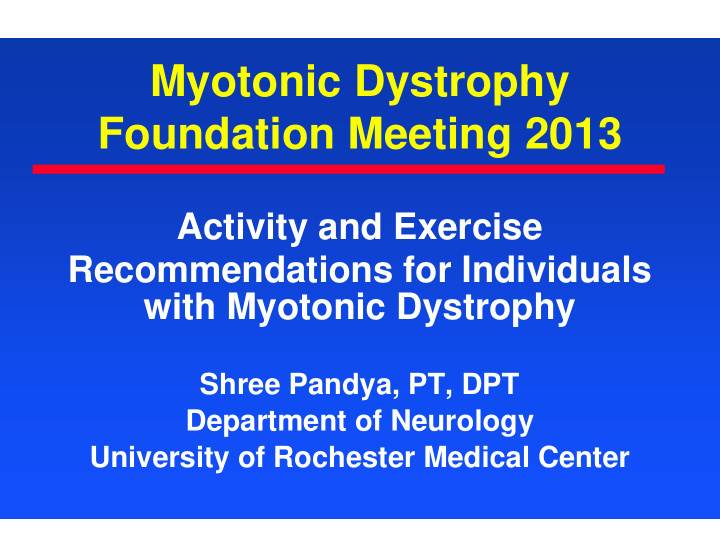



Myotonic Dystrophy Foundation Meeting 2013 Activity and Exercise Recommendations for Individuals with Myotonic Dystrophy Shree Pandya, PT, DPT Department of Neurology University of Rochester Medical Center
Physical Activity and Health The Benefits of Physical Activity • Helps control weight • Reduces risk of cardiovascular disease • Reduces risk for type 2 diabetes • Reduces risk of some cancers • Strengthens bones and muscles • Improves mental health and mood • Improves ability to do daily activities • Increases chance of living longer
2008 Physical Activity Guidelines for Americans http://www.health.gov/ paguidelines/guidelines/ default.aspx
Recommendations from 2008 Guidelines Adults need at least • 2 hrs and 30 minutes (150 minutes) of moderate intensity aerobic activity every week • Spread your activity out during the week 30 minutes x 5 days = 150 minutes • Break it up into smaller chunks of time during the day. 10 minutes at a time is fine • Moderate intensity activities are activities where you can still carry on a conversation such as brisk walking, raking, mowing, cycling, line dancing
Recommendations from 2008 Guidelines Adults need at least • 2 or more days a week of muscle strengthening activities that work all major muscle groups (legs, hips, abdomen, back, shoulders and arms). • You can use body weight, free weights, elastic bands, aquatherapy or equipment for resistance.
Current Recommendations for Individuals with DM • Aerobic/cardiovascular exercise • Resistance/strength training • Flexibility/range of motion • Balance training • Weight bearing
Evidence for Current Recommendations in DM • “Moderate intensity strength training appears not to harm muscles in people with DM” Cochrane,2010 • “There is level II evidence (likely to be effective) for strengthening exercises in combination with aerobic exercises for patients with muscle disorders” Cup, 2007 • “Aerobic training is safe and can improve fitness effectively in patients with myotonic dystrophy” Orngreen, 2005
Factors Affecting Individual Recommendations • Age (pediatric/adult) • Clinical profile (phenotype/current status) • Personal profile (work, family role, interests, financial/environmental/social barriers, facilitators)
Implementation • Evaluation by healthcare provider • Recommendations from health care provider • Regular monitoring and adjustments as necessary by provider • Self monitoring (Providers may include primary care provider, neuromuscular specialist or rehabilitation specialist)
Recommendations • Pick activities that you enjoy, work with a partner – spouse, parent, child, friend, co-worker if you can. • Start with short sessions 1-2 days/week and gradually build up to 30 minute sessions 5 days/week. • Give the routine a try for at least 3 months, it takes that long to see benefits! Do not get discouraged.
Physical Activity Profile and Barriers to Physical Activity in Individuals with Myotonic Dystrophy Eichinger KJ, Dekdebrun J, Dilek N, Chen D, Pandya S • Survey performed at EMPOWER 2011 meeting • Findings presented at World Muscle Society meeting 2013
Background • Individuals with myotonic dystrophy (DM) are less active than healthy individuals, which may result in secondary complications and decreased functional abilities (Wiles, et al., 2007) • Information regarding participation in physical activities and exercise has not been reported for individuals with DM in the USA
Methods • Individuals attending the Empower 2011 Patient and Family Conference, held in Clearwater, FL and sponsored by the Myotonic Dystrophy Foundation, were invited to participate in this study • Participants were asked to complete a demographic/clinical profile, the Barriers to Physical Activity and Disability Survey (BPADS) and the International Physical Activity Questionnaire (IPAQ) • Physical activity was reported as the number of days and time spent (10 minute increments) over the past 7 days
Results Subjects • 107 participants (53% male) with DM (65% DM1) • Mean age = 45.7 years (20-77) • Mean age of onset − DM1= 28.5 years (12-70); DM2= 33.4 years (7-64)
Results Current Clinical Problems N(%) Ankle weakness 48 (44.9) Leg weakness 62 (57.9) Finger and hand weakness 79 (73.8) Arm weakness 49 (45.8) Myotonia 59 (55.1) Pain 47 (43.9) Fatigue 73 (68.2) Daytime sleepiness 71 (66.4) Gastrointestinal (stomach) problems 71 (66.4) Cardiac (heart) problems 32 (29.9) Pulmonary (breathing) problems 17 (15.9) Neurocognitive problems 25( 23.4)
Results Barriers to Exercise N(%) Cost of the exercise program 30 (28.0) Lack of transportation 11 (10.3) Lack of time 31 (29.0) Lack of interest 24 (22.4) Lack of energy 54 (50.5) Lack of motivation 50 (46.7) Exercise is boring/monotonous 23 (21.5) Exercise will not improve my condition 18 (16.8) Exercise will make my condition worse 14 (13.1) Exercising is too difficult 14 (13.1) Health concerns prevent me from exercising 11 (10.3) Pain prevents me from exercising 19 (17.8) Feel uncomfortable or self-conscious in a fitness center 28 (26.2)
Results The percentage of individuals who performed moderate intensity level physical activity on at least 1 day in the categories of gardening, household work, walking, and recreational activities.
Results • The time spent sitting was reported to be 7.5 hours on average per day
Recommendations • Recent findings suggest prolonged sitting is deleterious • Recommend moving for 10 minutes every hour
References • Nicoline BM Voet, van der Kooi AJ, Riphagen I, et al. Strength training and aerobic exercise training for muscle disease. The Cochrane Librar y. 2010;2. • To sweat or not to sweat. Quest: MDA’s Research and Health Magazine. 2009;24-41. • Cup EH, Pieterse AJ, ten Broek-Pastoor J, et al. Exercise therapy and other types of physical therapy for patients with neuromuscular diseases; a systematic review. Arch Phys Med Rehabil. 2007;88:1452-1464. • Orngreen MC, Olsen DB, Vissing J. Aerobic training in patients with myotonic dsytrophy type 1. Ann Neuro l. 2005;57:754-757. • Lindeman E, Leffers P, Spaans F, et al. Strength training in patients with myotonic dystrophy and hereditary motor and sensory neuropathy: A randomized clinical trial. Arch Phys Med Rehabi l. 1995;76:612-620. • http://www.health.gov/paguidelines/guidelines/default.aspx • National Center on Health, Physical Activity and Disability http://www.nchpad.org
Recommend
More recommend